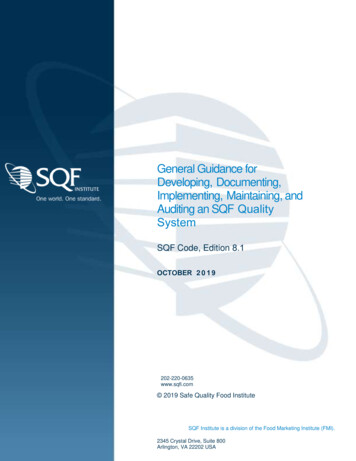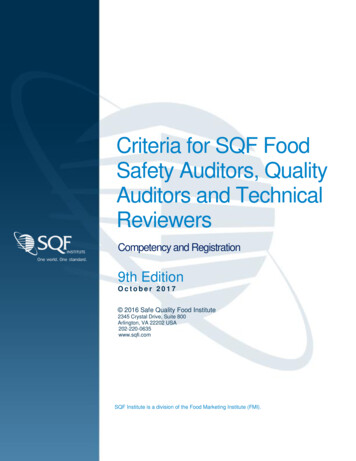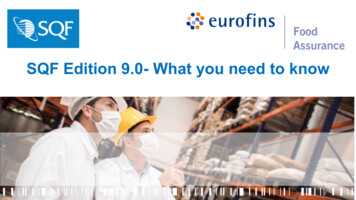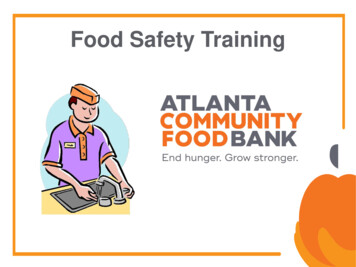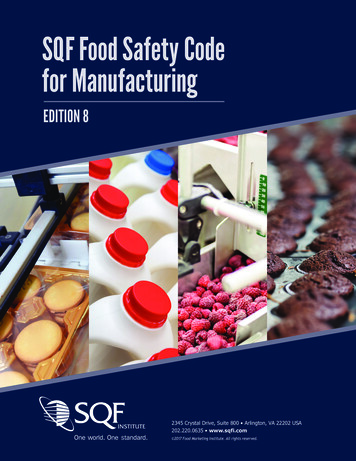
Transcription
SQF Food Safety Codefor ManufacturingEDITION 82345 Crystal Drive, Suite 800 Arlington, VA 22202 USA202.220.0635 www.sqfi.com 2017 Food Marketing Institute. All rights reserved.
The SQF Code, Edition 8First published May 1995Introduction 2017 Food Marketing Institute (FMI). All rights reserved.First Printed May 1995No portion of this document may be reproduced or used in any manner whatsoever without the express writtenpermission of the Food Marketing Institute. For permission contact FMI at 2345 Crystal Drive, Suite 800, Arlington,VA, 22202, USA. Care should be taken to ensure that material used is from the current edition of the Code and that itis updated whenever the Code is amended or revised. The date of the Code should therefore be clearly identified.Suggestions for improvements to this Code are encouraged from all parties. Written comments are to be sent to SQFIat 2345 Crystal Drive, Suite 800, Arlington, VA, 22202, USA.SQF Code edition 8 2017 Food Marketing Institute. All rights reserved.1
The SQF Code, Edition 8First published May 1995IntroductionSQF Code, edition 8The Safe Quality Food Institute’s (SQFI) SQF Code, edition 8 has been updated and redesigned in 2017 for use by allsectors of the food industry from primary production to storage and distribution and now includes a food safety codefor retailers. It replaces the SQF Code, edition 7.The SQF Code is a site-specific, process and product certification standard with an emphasis on the systematicapplication of CODEX Alimentarius Commission HACCP principles and guidelines for control of food safety and foodquality hazards.Certification to the SQF Code supports industry- or company-branded product and offers benefits to certified sitesand their customers. The implementation of an SQF System addresses a buyer’s food safety and quality requirementsand provides the solution for businesses supplying local and global food markets. Products produced andmanufactured under SQF Code certification retain a high degree of acceptance in global markets.First developed in Australia in 1994, the SQF program has been owned and managed by the Food Marketing Institute(FMI) since 2003, and was first recognized in 2004 by the Global Food Safety Initiative (GFSI)* as a standard thatmeets its benchmark requirements.Certification of a site’s SQF System by a Safe Quality Food Institute licensed certification body is not a statement ofguarantee of the safety of the site’s product, or that it meets all food safety regulations at all times. However, it is anassurance that the site’s food safety plans have been implemented in accordance with the CODEX HACCP method aswell as applicable regulatory requirements and that the System has been verified and determined effective tomanage food safety. Further, it is a statement of the site’s commitment to1. produce safe, quality food,2. comply with the requirements of the SQF Code, and3. comply with applicable food legislation.SQF Code, edition 8 is applicable to all certification and surveillance audits conducted after January 2, 2018. Thosesites with an existing SQF certification will be required to upgrade their Systems to meet the requirements outlined inedition 8 by that date.This reference document is published in English, but is also available in other languages. Where there is anydivergence between the translated version and the reference document, the English reference document will prevail.For further definition of words used in this document, please refer to Appendix 2: Glossary.*The Global Food Safety Initiative (GFSI) is an industry initiative established by the international trade association,the Consumer Goods Forum.SQF Code edition 8 2017 Food Marketing Institute. All rights reserved.2
The SQF Code, Edition 8First published May 1995IntroductionContentsSQF Code, edition 8 . 2Part A: Implementing and Maintaining the SQF Food Safety Code for Manufacturing. 131.2.3.4.Preparing for Certification . 131.1Learn about the SQF Food Safety Code for Manufacturing . 141.2Select the Relevant SQF Modules. 141.3Register on the SQF Database . 161.4Use of SQF Consultants . 161.5Designate an SQF Practitioner . 161.6SQF Implementation Training . 161.7Document and Implement the SQF Food Safety Code for Manufacturing. 161.8SQF Guidance Documents . 171.9Select a Certification Body . 171.10Conduct a Pre-assessment Audit . 17The Initial Certification Process . 182.1Selection of the SQF Auditor(s) . 182.2Identifying the Scope of Certification . 182.3The Initial Certification Audit . 182.4Identifying the Scope of the Audit . 192.5Audit Duration Guide . 192.6The Desk Audit . 202.7The Site Audit . 202.8Corporate Audits . 212.9Seasonal Production . 212.10System Elements . 212.11Non-conformities . 222.12Audit Evidence Record and Audit Report. 22The Initial Certification Decision. 233.1Responsibility for the Certification Decision . 233.2Site Audit Corrective Actions . 233.3Audit Score and Rating . 233.4Granting Certification . 243.5Failure to Comply . 24Surveillance and Re-certification . 254.1Maintaining Certification . 254.2Surveillance Audit . 254.3Surveillance Audit – Seasonal Operations . 254.4Re-certification Audit. 254.5Re-certification Audit – Seasonal Operations . 264.6Variations to the Re-certification Process . 264.7Unannounced Re-certification Audit . 264.8Suspending Certification. 274.9Withdrawing Certification . 28SQF Code edition 8 2017 Food Marketing Institute. All rights reserved.3
The SQF Code, Edition 8First published May 19955.IntroductionObligations of Sites and Certification Bodies . 295.1Changing the Scope of Certification . 295.2Changing the Certification Body . 295.3Notification of Product Recalls and Regulatory Infringements . 295.4Compliance and Integrity Program . 305.5Change of Ownership . 305.6Relocation of Premises . 305.7Use of a Technical Expert . 305.8Language . 305.9Conflict of Interest. 315.10Complaints, Appeals and Disputes . 31Part B: The SQF Food Safety Code for Manufacturing . 32Scope, References and Definitions . 32Scope . . 32References . 32Definitions . 32SQF System Elements for Food Manufacturing . 332.1Management Commitment . 332.1.1Food Safety Policy (Mandatory) . 332.1.2Management Responsibility (Mandatory) . 332.1.3Management Review (Mandatory) . 342.1.4Complaint Management (Mandatory) . 342.1.5Crisis Management Planning . 342.2Document Control and Records . 352.2.1Food Safety Management System (Mandatory) . 352.2.2Document Control (Mandatory) . 352.2.3Records (Mandatory) . 352.3Specification and Product Development . 352.3.1Product Development and Realization . 352.3.2Raw and Packaging Materials . 352.3.3Contract Service Providers. 362.3.4Contract Manufacturers . 362.3.5Finished Product Specifications . 362.4Food Safety System . 362.4.1Food Legislation (Mandatory) . 362.4.2Good Manufacturing Practices (Mandatory) . 372.4.3Food Safety Plan (Mandatory) . 372.4.4Approved Supplier Program (Mandatory) . 382.4.5Non-conforming Product or Equipment . 382.4.6Product Rework . 392.4.7Product Release (Mandatory) . 392.4.8Environmental Monitoring . 392.5SQF System Verification . 392.5.1Validation and Effectiveness (Mandatory) . 392.5.2Verification Activities (Mandatory) . 392.5.3Corrective and Preventative Action (Mandatory) . 39SQF Code edition 8 2017 Food Marketing Institute. All rights reserved.4
The SQF Code, Edition 8First published May 1995Introduction2.5.4Product Sampling, Inspection and Analysis . 402.5.5Internal Audits and Inspections (Mandatory). 402.6Product Identification, Trace, Withdrawal and Recall . 402.6.1Product Identification (Mandatory) . 402.6.2Product Trace (Mandatory) . 402.6.3Product Withdrawal and Recall (Mandatory) . 412.7Food Defense and Food Fraud. 412.7.1Food Defense Plan (Mandatory). 412.7.2Food Fraud . 412.8Allergen Management . 422.8.1Allergen Management for Food Manufacturing (Mandatory). 422.8.2Allergen Management for Pet Food Manufacturing (Mandatory) . 432.8.3Allergen Management for Manufacturers of Animal Feed . 432.9Training . 432.9.1Training Requirements . 432.9.2Training Program (Mandatory) . 432.9.3Instructions . 432.9.4HACCP Training Requirements . 432.9.5Language . 432.9.6Refresher Training . 432.9.7Training Skills Register. 43Module 3: Good Manufacturing Practices for Animal Feed Production (GFSI Scope F) . 453.1Site Location and Construction . 453.1.1Premises Location . 453.2Construction and Control of Product Handling and Storage Areas . 453.2.1Materials and Surfaces . 453.2.2Floors, Drains and Waste Traps . 453.2.3Walls, Partitions, Doors and Ceilings . 453.2.4Stairs, Catwalks and Platforms . 453.2.5Lighting and Light Fittings . 453.2.6Inspection/Quality Control Area . 463.2.7Dust, Insect, and Pest Proofing . 463.2.8Ventilation . 463.2.9Equipment, Utensils and Protective Clothing . 463.2.10Premises and Equipment Maintenance . 463.2.11Calibration. 473.2.12Pest Prevention . 473.2.13Cleaning and Sanitation . 483.3Personnel Hygiene and Welfare . 483.3.1Personnel . 483.3.2Hand Washing. 493.3.3Clothing . 493.3.4Jewelry and Personal Effects . 493.3.5Visitors . 493.3.6Staff Amenities . 493.3.7Change Rooms . 49SQF Code edition 8 2017 Food Marketing Institute. All rights reserved.5
The SQF Code, Edition 8First published May 1995Introduction3.3.8Sanitary Facilities . 493.3.9Lunch Rooms . 503.4Personnel Processing Practices. 503.4.1Staff Engaged in Feed Handling and Processing Operations. 503.4.2Product Formulation . 503.4.3Application of Medicines . 503.5Water and Air Supply . 503.5.1Water Supply . 503.5.2Monitoring Water Microbiology and Quality . 513.5.3Water Delivery . 513.5.4Water Treatment . 513.5.5Analysis . 513.5.6The Quality of Air and Other Gasses . 513.6Storage and Transport . 513.6.1Storage and Handling of Goods . 513.6.2Cold Storage, Freezing and Chilling . 513.6.3Storage of Dry Ingredients, Packaging, and Finished Product . 513.6.4Storage of Equipment and Containers . 523.6.5Storage of Hazardous Chemicals and Toxic Substances . 523.6.6Alternative Storage and Handling of Goods . 523.6.7Loading, Transport and Unloading Practices . 523.6.8Loading . 523.6.9Unloading . 523.7Separation of Functions . 523.7.1Process Flow . 523.7.2Receipt of Raw and Packaging Materials and Ingredients . 523.7.3Thawing of Food . 533.7.4Control of Foreign Matter Contamination . 533.7.5Detection of Foreign Objects . 533.7.6Managing Foreign Matter Contamination Incidents . 533.8On-Site Laboratories . 533.8.1Location . 533.9Waste Disposal . 533.9.1Dry and Liquid Waste Disposal . 533.10Exterior . 543.10.1Grounds and Roadways . 54Module 4: Good Manufacturing Practices for Processing of Pet Food Products (GFSI Scope F) . 554.1Site Location and Construction . 554.1.1Premises Location and Approval . 554.1.2Construction and Operational Approval . 554.2Construction of Premises and Equipment . 554.2.1Materials and Surfaces . 554.2.2Floors, Drains and Waste Traps . 554.2.3Walls, Partitions, Floors and Ceilings . 554.2.4Stairs, Catwalks and Platforms . 554.2.5Lighting and Light Fittings . 554.2.6Inspection/Quality Control Area . 56SQF Code edition 8 2017 Food Marketing Institute. All rights reserved.6
The SQF Code, Edition 8First published May 1995Introduction4.2.7Dust, Insect, and Pest Proofing . 564.2.8Ventilation . 564.2.9Equipment, Utensils, and Protective Clothing . 564.2.10Premises and Equipment Maintenance . 564.2.11Calibration. 574.2.12Pest Prevention . 574.2.13Cleaning and Sanitation . 584.3Personnel Hygiene and Welfare . 594.3.1Personnel . 594.3.2Hand Washing.
SQF Food Safety Code for Manufacturing EDITION 8 2345 Crystal Drive, Suite 800 Arlington, VA 22202 USA 202.220.0635 www.sqfi.com 2017 Food Marketing Institute.
